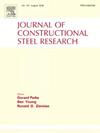单对称波纹腹板梁侧扭屈曲特性试验研究
IF 4
2区 工程技术
Q1 CONSTRUCTION & BUILDING TECHNOLOGY
引用次数: 0
摘要
单对称梁通过提高抗压翼缘的面外刚度来提高侧扭屈曲强度是一种推荐的解决方案。该应用广泛用于工业应用,如起重机轨道梁。另一方面,波纹腹板钢梁由于其显著的优点在世界范围内得到了广泛的应用。因此,引入单对称波纹腹板梁(MSCWGs)结合了这两种截面的优点。然而,文献表明,对此类梁的研究是有限的,对此类梁的实验研究是罕见的。因此,本文通过对四个钢梁在均匀纯弯矩(PBM)作用下的试验研究了mscwg的LTB行为。研究的关键参数为梁深、压边宽度和压边厚度,其他参数保持不变。随后,利用有限元分析软件Abaqus进行了含缺陷的几何和材料非线性分析(GMNIA),并将模拟试验结果与实验结果进行了验证。然后将实验研究扩展为参数化研究,以深入了解PBM作用下MSCWGs的LTB行为。研究表明,减小压缘尺寸会降低截面抗弯刚度和截面面外刚度,导致截面竖向和侧向位移增大,截面抗弯能力降低。此外,结果表明,在相同的法兰面积下,与改变压缩法兰厚度相比,改变压缩法兰宽度对mscwg的行为有显著的影响。最后,将有限元结果与基于EC3设计方法的mscwg现有设计模型进行了比较。本文章由计算机程序翻译,如有差异,请以英文原文为准。
Experimental study of lateral torsional buckling behaviour of mono-symmetric corrugated web girders
Mono-symmetric girder is a recommended solution to enhance lateral torsional buckling (LTB) strength by enhancing the out-of-plane stiffness of the compression flange. This application is intensively used in industrial applications such as crane track girders. On the other hand, using steel girders with corrugated webs (CWGs) became a worldwide application because of their remarkable advantages. Thus, introducing mono-symmetric plate girders with corrugated webs (MSCWGs) combines the merits of both sections. However, the literature shows that investigations for such girders are limited, and experimental studies for such type of girders are rare. Hence, in this paper, the LTB behaviour of MSCWGs is investigated experimentally by testing four steel girders under the effect of uniform pure bending moment (PBM). The key investigated parameters are the depth of girder, the width of compression flange and the thickness of compression flange, while other parameters are kept the same. After that, a geometrically and materially nonlinear analyses with imperfection included (GMNIA) is performed using the finite element (FE) analysis software Abaqus, and the results of the simulated tests are verified with the experimental results. Then the experimental study is extended for a parametric study to deeply comprehend the LTB behaviour of MSCWGs under the effect of PBM. The performed study showed that, decreasing the compression flange dimensions, decreases the section flexural rigidity and the section out-of-plane stiffness, which results in increasing vertical and lateral displacements and decreases the section flexural capacity. Additionally, the results notify that varying compression flange width has a remarkable impact on the behaviour of MSCWGs compared with varying the compression flange thickness for the same flange area. Finally, the FE results are compared with available design models for MSCWGs based on EC3 design approach for flexural strength.
求助全文
通过发布文献求助,成功后即可免费获取论文全文。
去求助
来源期刊

Journal of Constructional Steel Research
工程技术-工程:土木
CiteScore
7.90
自引率
19.50%
发文量
550
审稿时长
46 days
期刊介绍:
The Journal of Constructional Steel Research provides an international forum for the presentation and discussion of the latest developments in structural steel research and their applications. It is aimed not only at researchers but also at those likely to be most affected by research results, i.e. designers and fabricators. Original papers of a high standard dealing with all aspects of steel research including theoretical and experimental research on elements, assemblages, connection and material properties are considered for publication.
 求助内容:
求助内容: 应助结果提醒方式:
应助结果提醒方式:


